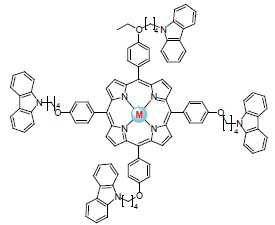| [1] (a) Sun, Y.; Hu, X. B.; Li, H. R. Comput. Theor. Chem. 2011, 966, 62.(b) Abu-Omar, M. M. Dalton Trans. 2011, 40, 3435.[2] (a) Fukuzumi, S.; Liu, J. Y.; El-Khouly, M. E.; Nq, D. K. Chem. Eur. J. 2011, 17, 1605.(b) Maligaspe, E.; Kumpulainen, T.; Subbaiyan, N. K.; Zandler, M. E.; Lemmetyinen, H.; Tkachenko, N. V.; D'Souza, F. Phys. Chem. Chem. Phys. 2010, 12, 7434.(c) Wallin, S.; Monnereau, C.; Blart, E.; Gankou, J. R.; Odobel, F.; Hammarström, L. J. Phys. Chem. A 2010, 114, 1709.[3] (a) She, C. X.; Lee, S. J.; McGarrah, J. E.; Vura-Weir, J.; Wasielewski, M. R.; Chen, H. N.; Schatz, G. C.; Ratner, M. A.; Hupp, J. T. Chem. Commun. 2010, 46, 547.(b) Morisue, M.; Morita, T.; Kuroda, Y. Org. Biomol. Chem. 2010, 8, 3457.[4] (a) Karousis, N.; Sandanayaka, A. S. D.; Hasobe, T. J. Mater. Chem. 2011, 21, 109.(b) Xiang, N.; Liu, Y. J.; Zhou, W. P.; Huang, H.; Guo, X.; Tan, Z.; Zhao, B.; Shen, P.; Tan, S. T. Eur. Polym. J. 2010, 46, 1084.(c) Wu, S. L.; Lu, H. P.; Yu, H. T.; Chuang, S. H.; Chiu, C. L.; Lee, C. W.; Diau, E. W. G.; Yeh, C. Y. Energy Environ. Sci. 2010, 3, 949.[5] (a) Xin, H.; Li, F. Y.; Guan, M.; Huang, C. H.; Sun, M.; Wang, K. Z.; Zhang, Y. A.; Jin, L. P. J. Appl. Phys. 2003, 94, 4729.(b) Zhang, L. Y.; Li, T. L.; Li, B.; Lei, B. F.; Yue, S. M.; Li, W. L. J. Lumin. 2007, 126, 682.[6] Li, Y. Q.; Rizzo, A.; Salerno, M.; Mazzeo, M. Appl. Phys. Lett. 2006, 89, 061125.[7] (a) Lian, W.-H.; Wang, B.-B.; Sun, Y.-Y.; Shan, N.; Yu, L.-X.; Yu, M.; Shi, T.-S. Chin. J. Org. Chem. 2012, 32, 113 (in Chinese).(连文慧, 王彬彬, 孙园园, 单凝, 于连香, 于苗, 师同顺, 有机化学, 2012, 32, 113.)(b) Lian, W. H.; Sun, Y. Y.; Wang, B. B.; Shan, N.; Shi, T. S. J. Serb. Chem. Soc. 2012, 77, 335.[8] Thomas, D. W.; Martell, A. E. J. Am. Chem. Soc. 1956, 78, 1335[9] Inokuma, Y.; Osuka, A. Org. Lett. 2004, 6, 3663.[10] Guo, X.-M.; Shi, T.-S.; Su, L.-J. Chem. J. Chin. Univ. 2006, 27, 410 (in Chinese).(郭喜明, 师同顺, 苏连江, 高等学校化学学报, 2006, 27, 410.)[11] Sun, Y.-Y.; Lian, W.-H.; Wang, J.-C.; Wang, B.-B.; Shan, N.; Yu, L.-X.; Yu, M.; Shi, T.-S. Acta Chim. Sinica 2011, 69, 2465 (in Chinese)(孙园园, 连文慧, 王建成, 王彬彬, 单凝, 于连香, 于苗, 师同顺, 化学学报, 2011, 69, 2465).[12] Sun, E.-J.; Wang, D.; Cheng, X.-L.; Shi, Y.-H.; Shi, T.-S. Chem. J. Chin. Univ. 2007, 28, 1208 (in Chinese).(孙二军, 王栋, 程秀利, 师宇华, 师同顺, 高等学校化学学报, 2007, 28, 1208.)[13] Paulat, F.; Franeeth, V. K. K.; Lehnert, N.; Lether, C. Inorg. Chem 2006, 45, 2835.[14] Quimby, D. J.; Longo, F. R. J. Am. Chem. Soc. 1975, 97, 5111.[15] Zheng, W. Q.; Shan, N.; Yu, L. X.; Wang, X. Q. Dyes Pigm. 2008, 77, 153.[16] Zhao, Z. X.; Xie, T. F.; Li, D. M.; Wang, D. J.; Liu, G. F. Synth. Met. 2001, 123, 33.[17] Guo, X. M.; Shi, T. S. J. Mol. Struct. 2006, 789, 8. |
